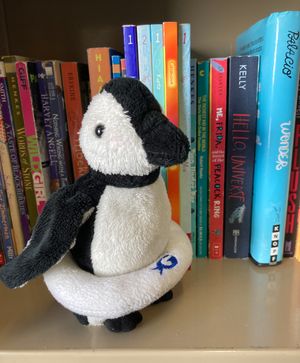From: https://www.edutopia.org/article/classroom-management-tips-new-teachers-new-teacher?fbclid=IwAR1x2u2KGSUGXxVsZLilFel6BY19eLz9OzaxLBezuaG6CY2aj3GIDIoFi5w
Classroom Management Tips for New Teachers, From a New Teacher
A first-year elementary teacher transformed her classroom with a focus on social and emotional learning—and a little help from Penny the Positivity Penguin.

Earlier this year, I was monitoring the hallway as students switched classes after lunch. The boys in the bathroom were making a slight ruckus, but it wasn’t out of hand (yet).
Another student came to stand next to me, asking “Ms. McErlain?” as she tried to get my attention.
“What’s up?” I asked, barely glancing at her, mostly keeping an eye on the boys’ bathroom.
The student was silent, so I finally turned my attention to her.
“Something happened in the cafeteria,” she said, as the tears started rolling down her face. “Everyone surrounded me and called me names.” I asked if it was OK to give her a hug as I requested support from my administration and school counselor.
When I finally finished teaching that day, I went home discouraged. I realized that my classroom wasn’t the happy place I wanted it to be. As a first-year teacher of fourth grade, I had entered the workforce with rose-colored glasses and big dreams of impacting the lives of my students—but I had no idea how to really change their lives. While my college professors preached meeting Maslow’s hierarchy of needs before teaching Bloom’s taxonomy, I didn’t know specific and practical ways to build relationships and community. That night, I came up with four immediate ways I could change the climate of my classroom by prioritizing social and emotional learning.
4 IDEAS THAT ARE WORKING FOR ME
1. Soft starts: Traditionally, when students arrived in the morning, they were expected to get straight to academic work. In my first semester, I noticed that my students were off-task, ignoring their morning work and acting out. I saw that they needed a space for connection before starting their day.
Now, when you walk into my classroom in the morning, you hear students quietly chatting and music playing for the first 20 minutes. I create a weekly choice board that includes drawing, reading, and writing prompts to ease students into the day. The entire vibe of the classroom has shifted from chaotic, restless energy to a calm environment, where students get what they need to start their day off right.
2. A good friend for the whole class: As I was brainstorming ways to change my classroom environment, I found a stuffed animal that I spontaneously named Penny the Positivity Penguin. I brought her in on a whim, and was astonished to see Penny’s impact. Although the childhood magic of stuffed animals has somewhat faded by fourth grade, Penny has become part of the class. We write her letters, and she responds. She tries to write neatly, even though it’s difficult to hold a pen with her wings. When students are working hard, she hops up to their desk to observe more closely. She’s become a positive role model.
3. Community circle: Community circle is one of my favorite things (and my students love it too). I started holding a community circle because I noticed the negative ways my students talked to each other. We needed to practice respectful language. At the beginning of class, students meet on the floor in a circle for 10 minutes. Every day, we go over our community circle guidelines. We use Penny the Positivity Penguin as our talking device to help regulate turn taking.
Here are our guidelines:
- We respect each other by not talking when someone else is holding the penguin and by looking at the person who is talking.
- We respect ourselves by waiting for others’ attention and by speaking loudly, because our words matter and others deserve to hear our ideas.
- We respect Penny, because she is a penguin and she doesn’t know how to fly, so we’re going to gently pass her and never throw her through the air.
Next, we greet the person sitting next to us. This changes daily. Sometimes we say, “Hola, Hannah.” Other days, we use compliments like “You are so smart, Daniel.” We try greetings in languages related to our students’ cultures or languages they’d like to learn. Then, we answer a funny question, like “What kind of superpower do you wish you had?” We usually end with a more serious question, such as “What’s something you admire about the person next to you?”
4. Quick check-ins: I started creating Google Forms to check in with my students. I post these forms at least twice a week, with an emotion check-in and then an open-ended question, such as, “Which three words best describe you? What’s something that’s really difficult for you? Anything else I should know?” Then I say, “I’m always here for you. If you need a hug, I’m here. If you need to share something (whether it’s your feelings or a silly fun fact), I’d love to hear.”
These check-ins have also become a place where students can tell me about their genuine selves. When a student used the Google Form to share that they were worried about the war in Ukraine, I realized that I wanted to work harder at creating a relationship with my quieter, more reserved students. I hate that it took me until February to learn that one of my students loves playing piano. Another student described himself as stupid, and I realized that this brilliant kid has low self-esteem. I’ve learned so much about my students through these simple check-ins.
There are a variety of classroom management strategies that can help first-year teachers find their footing. However, these are the four that have significantly altered my students’ attitudes and openness toward me. I had to discover my own ways to connect with students beyond what was taught in my education classes. I wish I had started building these relationships sooner, especially as I discover more and more of my students’ interests and challenges. If you’re in the same spot I was, it’s not too late: Find your own Penny the Positivity Penguin and use her as a springboard to transform your classroom culture.


No comments:
Post a Comment